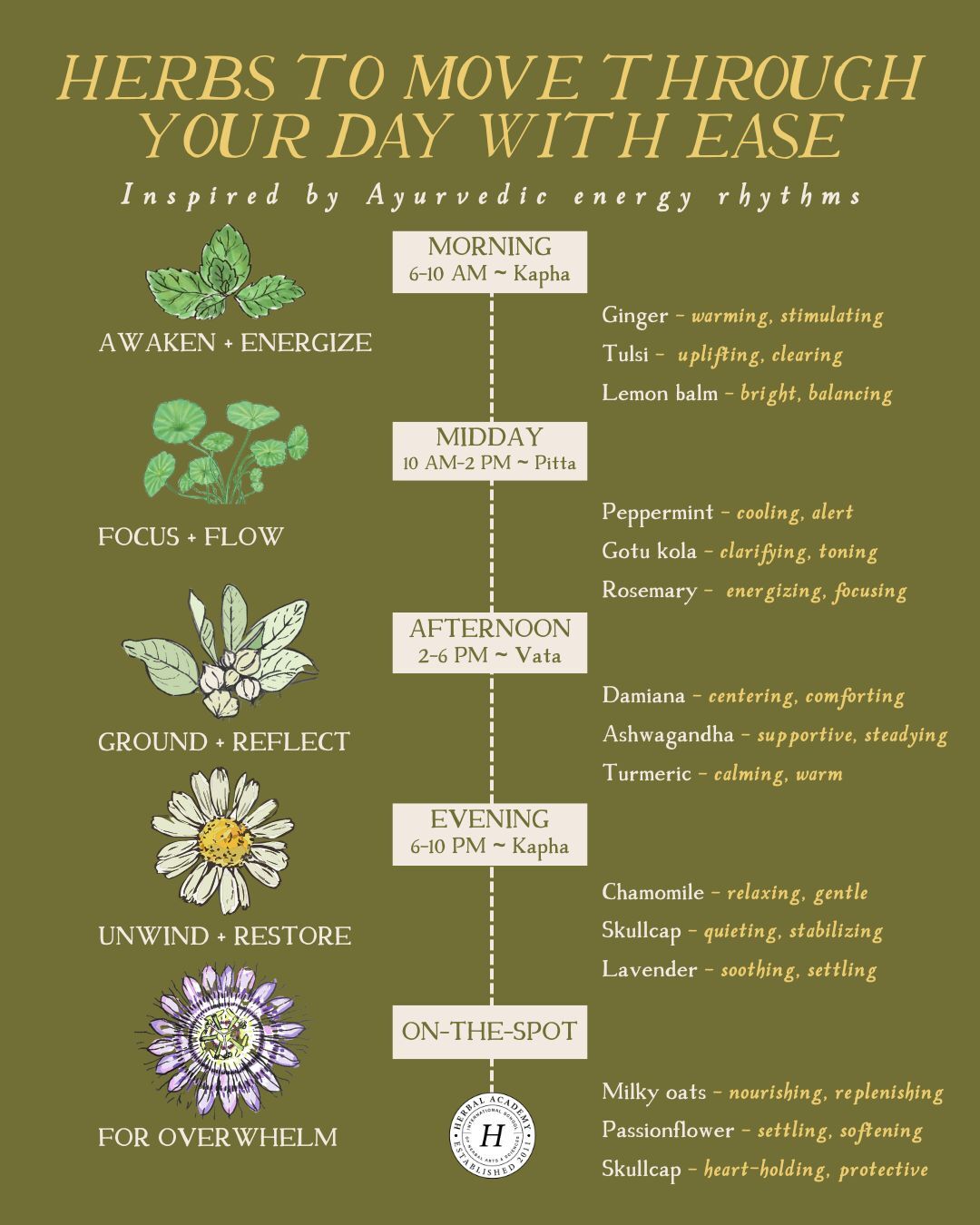
How to Schedule Your Day Based on Energy Levels
Ayurveda teaches that one of the root causes of health imbalances is living out of harmony with nature. However, living in harmony with nature is no small feat, especially in the modern day. Furthermore, what exactly does it mean to “live in harmony?” Fortunately, Ayurveda offers a rich perspective on this. Your constitution, the seasons, time of life, and time of day can all help point the way. There is a relationship between the movement of time, the phases of the moon, exposure to solar energy, and the flow of the doshas (Lad, 2009). Aligning your daily routines with the ebb and flow of the doshas throughout the day can be one way to create balance in your life. This article will discuss how to schedule your day based on your natural energy levels—and how Ayurveda can inform those decisions.

Cool and Dreamy: Vata Time
The early hours of the morning (2-6 am) and the afternoon (2-6 pm) are the times of day in which vata dosha is strongest (Tiwari, 1995). If you are a vata type or if it’s autumn (vata season) you may feel like all day is the vata time of day! Nonetheless, Ayurveda teaches that from 2-6 am and 2-6 pm is the time of day in which vata dosha rules.
What does this mean? First, let’s consider some of the qualities of vata dosha. As ayurvedic practitioner, teacher, and author Maya Tiwari (1995) describes so poetically, “Swift as a deer, cold as ice. The coldness of the harsh winds against the variegated sands of the desert nights—such is the nature of vata” (p. 44). Cool, swift, subtle, mobile, and perhaps even stark are some of the qualities that exemplify vata dosha. Those with a vata constitution tend to have a cool body temperature, dry skin, a light frame, and a subtle, creative, independent approach to their work.
Also, since vata is composed of air and ether, air lends movement and enthusiasm while ether provides spaciousness and imagination. Vata types may be naturally drawn to the subtle, spiritual realms. The mobile nature of vata dosha can also create restlessness and trouble with sleep. These vata qualities may crop up especially during the vata times of day and night, regardless of one’s inherent constitution.

Keep Vata Grounded
Vata types in particular may experience restless sleep or insomnia from 2-6 am (Tiwari, 1995). This may be true for pitta and kapha types as well. Vata dosha is closely connected to the nervous system. Therefore, forming good sleep habits and doing your best to manage stress can help prevent disturbed sleep and restlessness, particularly from 2-6 am.
Oftentimes, subconscious or residual stress— or perhaps excitement—will cause disturbed sleep in the wee hours of the morning. I have personally experienced this on a number of occasions. Let’s say I gave a public talk, helped to plan a large event, or taught a workshop. I may slip off to dreamland in a state of exhausted relief at 10 or 11 pm, but then the leftover nervous energy will cause my eyes to pop wide open at 2 or 3 am.
Interestingly enough, sleep maintenance insomnia (difficulty staying asleep) is more common in older adults, whereas difficulty falling asleep tends to be more common in younger adults (Fiorentino & Martin, 2018). As we age, we move into what is considered the vata time of life, so this vata imbalance of early morning awakening and trouble staying asleep may become more prevalent.
What is to be done? Taking time to soothe the nerves before going to bed and establishing regular sleep routines will help calm vata dosha so that it won’t go into aggravation during vata time—2-6 am. You can read more about sleep-supporting routines in my Herbal Academy post 5 Lifestyle Hacks for Sound Sleep. It is worth mentioning that sticking to habits and routines is typically a challenge for vata types, whereas pitta and kapha types usually gravitate to routine. Yet, it is helpful for all types to learn how to schedule their day (and nights) to optimize rest and recovery.
Also, if you find your night’s rest frequently interrupted, you may want to consider ashwagandha (Withania somnifera) root for calming and tonifying the nerves and regulating sleep cycles. Ashwagandha is also, among other things, one of the best herbs for pacifying vata dosha. Or, check out 5 Herbal Insomnia Options for Better Sleep.

Go With The Flow
Though it is important to get adequate rest and to counteract vata’s mobile, restless qualities with grounding routines, you can also use the vata time of day to your advantage. Vata dosha relates closely to the subtle, spiritual, ethereal realms. Therefore, the vata time is ideal for meditation, yoga, breath work, chanting, mindfulness, and devotional practices. Also, you may find that you are less encumbered by family and work responsibilities in the early morning.
That said, be sure to get enough rest. No need to awaken at 2 am to practice yoga! But, arising with the sun—or a bit before sunrise—and having some quiet time to yourself may prove enjoyable and beneficial.
In addition, 2-6 pm tends to be a good time for dreaming, imagination, and expansive thinking. You may want to save this time in the afternoon for scheming and dreaming, journaling, and brainstorming. Or, particularly if you are a vata type, this may be a good time for a nap if you tend to feel fatigued or scattered at this time of day (Tiwari, 1995). Two to 6 pm is also a great time for a warm, vata-balancing beverage, such as tulsi chai or golden milk. Furthermore, light physical movement such as walking or restorative yoga are conducive to this time of day.
To sum it up, the 2-6 am and 2-6 pm are excellent times of day for reflection, yoga, mindfulness practices, expansive thinking, and rest. Be wary of scattering your energy or letting yourself run on nervous energy, especially during the vata times of day. You may find benefit in napping or doing other quieting, restorative practices in the afternoon. And, establishing good sleep habits can prevent waking up in the very early hours of the morning.

Active and Fiery: Pitta Time
Pitta dosha, the fiery dosha, is strongest from 10 am-2 pm and 10 pm-2 am (Tiwari, 1995). Pitta is full of fire, energy, and drive; and those qualities may come out strongest during the pitta times of day. Pitta time is a time of activity (Halpern, 2012). “The brilliance of a raging fire dragon in the city of sparkling gems—such is the nature of pitta” (Tiwari, 1995, p. 48).
Whereas vata is cool, subtle, and dreamy, pitta types run warm and tend to have a direct, to-the-point approach. Logic, leadership, and organization are all in the realm of pitta dosha. Those with a pitta constitution could become excellent directors, teachers, designers, architects, or scientists (Tiwari, 1995). Pitta types do need to guard against becoming overly domineering, driven, and judgmental. However, if they can keep their fiery nature in check, their courage, clear-thinking, and leadership skills will truly shine.
Feed the Fire
What does this mean for scheduling one’s day? To begin with, midday (pitta time) is the ideal time to eat the largest meal of the day. Noon is when pitta dosha and the agni (digestive fire) are at their peak (Tiwari, 1995). It is very important for pitta types in particular not to skip the midday meal. Since these fiery types tend to have a sharp, strong appetite, they may feel especially hungry between 10 am-2 pm. Therefore, this is the perfect time to have a satisfying, sit-down meal. However, pitta types should stick to mildly-spiced, cooling foods. Hot sauce, coffee, alcohol, and highly acidic foods are best avoided. Foods such as coconut, rice, cucumber, green juices, mung dal, and leafy greens are excellent choices for quelling the fire.
Even for vata and kapha types, midday is a good time for a proper meal—perhaps the largest meal of the day. But, these cooler types can enjoy more warmly spiced food. Also, though vata and kapha types typically do well to eat a substantial midday meal, they may not have the voracious appetite of their pitta counterparts. So, perhaps a small to moderate-sized meal will do just fine for vata or kapha at lunch. Vata types may need to have four small meals per day, and some kapha types do fine with just two small to moderate-sized meals per day. It’s all about tuning in to your appetite and seeing what works best with your metabolism and energy levels.

Stay Cool and Collected
Though pitta types are the natural movers and shakers of the world—and can be quite athletic as well—the heat of midday is not the ideal time to engage in strong athletic endeavors. Especially during the summer, it is wise to avoid vigorous physical activity when the sun is at its peak. Instead, activities such as jogging and cycling can be done in the cool of the morning or evening (Tiwari, 1995). Becoming overheated may not be a big concern for vata and kapha types, but even so, you may want to heed this guidance, particularly during the warmer months, or if you live in a place that is hot year-round.
So, be wary of getting overheated—be it physically, mentally, or emotionally—during the pitta time of day, But, you can use the pitta time to your advantage. You may find that activities that require logic, leadership, and organization are conducive to the pitta hours (just don’t get so busy that you don’t break for lunch!).
Give in to the Lunar Energy
The importance of good sleep habits is important for all types. Since 10 pm marks the onset of pitta time, you may feel a surge of energy or “second wind” at this time. There is a good reason why many dance clubs and parties open up at 10 pm! However, the wise pitta will aim to be in bed before this second surge of energy. (Unless you are a natural-born night owl!) This is true for all types, but especially for pitta types.
Maya Tiwari (1995) offers the sage advice of setting aside one’s worldly work at the day’s end. Pitta energy will tend to drive a person to become deeply invested in their work, and this can become all-consuming. Be wary of the urge to pick up a project late at night. Instead, perhaps experiment with surrendering to the nurturing, cooling lunar energy of kapha dosha and the dreamy aspects of vata dosha. Evening is an excellent time to dim the lights, light a candle, and connect with your loved ones. Or perhaps use the waning hours as a time to get in touch with your creative, intuitive, and reflective aspects.
To sum it up, don’t let pitta go hungry, and stay cool during the pitta times of day. Ten am to 2 pm may be a good time for productivity and work, but be sure to set aside time to unwind and relax at the day’s end.
Fluid and Strong: Kapha Time
Six to 10 am in the morning and 6 to 10 pm at night are the kapha times of day. These are the times of day in which there is an increase in kapha tendencies. Kapha dosha is cool, moist, heavy, solid, and stable. It is composed of earth and water. These qualities tend to come out strongest during the kapha times of day.
Maya Tiwari (1995) describes kapha dosha as, “Solid as a rock, cool as a glimmering stream in the white moonlight; such is the essence of kapha” (p. 52). Kapha types tend to be nurturing and reliable. They may be suited to familial responsibilities and are often the ‘heart’ of an organization. These earthy, watery types are also thoughtful, methodical, and have excellent stamina and endurance (Tiwari, 1995).

Make it Stick
So what does this mean in terms of how to schedule your day? To begin with, kapha types do well with routine, so if you want a habit to stick, consider scheduling it during the kapha time of morning or evening (6-10 am or 6-10 pm). Going back to the ideal times of day to exercise, kapha time is perfect for this. If you are looking to establish a regular physical movement practice, try 6 to 10 am or the early evening if mornings don’t work for you. The stick-to-it kapha energy will be in your favor and you can avoid the heat of the midday sun during the warm months.
Of course, depending on where you live, you may want to adjust the timing of your movement routine depending on the season. If you live somewhere that gets cold in the winter, you may want to take advantage of any sun and warmth you can get, and get outside to exercise in the late morning or early afternoon rather than the early morning or evening. There is indeed wisdom in adjusting your daily routines to be in step with the seasons.
Once kapha types develop a routine, they are great at maintaining momentum. But getting going can be a challenge. Kapha energy can become “intense, heavy, and rooted” (Tiwari, 1995, p. 55). The motivation to start is often the greatest challenge with kapha dosha. So, if you feel groggy or lethargic when you wake up at 6 am to begin a new morning routine, don’t be shocked—and don’t despair! Taking the steps to make your routine stick will be worth it. You may need to set an alarm or post up a motivational reminder in the beginning.
Also, if you tend to feel very heavy and slow in the mornings, consider drinking light, spicy teas such as ginger tea or a well-spiced chai, and keeping to a light breakfast. This will help balance out the heavy nature of kapha dosha. Energizing herbs may also be supportive. You can learn more about this in my post How to Use Herbs to Rebuild from Burnout. These hints at how to get motivated are particularly geared toward kapha types, but can apply to vata and pitta types as well, especially during late winter and early spring (kapha season).
Time to Connect
Also, kapha dosha is related to compassion and nurturing. Six to 10 am and 6 to 10 pm are good times to connect with friends and family. Perhaps you can invite your partner or a friend to join you for a morning walk, jog, or yoga class. Also, dinner (or supper) falls within kapha time, so the evening meal is a great chance to connect with friends, family, and loved ones.
To recap, get the stick-to-it kapha energy on your side to help create stable and lasting routines. Also, kapha time (6-10 am and 6-10 pm) is a good time for connection. Especially if you are a kapha type or it is kapha season you may need to go up against some inertia, so being prepared for those kapha tendencies especially during the kapha hours may help.
In Closing,
There is no one right way to schedule your day. Some people are early risers and some are night owls. The need for rest, activity, and nourishment vary from person to person. Tuning in to the ebb and flow of the doshas throughout the day—and their corresponding energies—is another way to become more aware of your own natural energy cycles. Use this as a guide and a means by which to experiment and observe…you may learn something new about yourself!

REFERENCES
Fiorentino, L. & Martin, J. (2018). Awake at 4 a.m.: Treatment of insomnia with early morning awakenings among older adults. Journal of Clinical Psychology, 66(11), 1161-1174. https://doi.org/:10.1002/jclp.20734
Lad, V. (2009). Ayurveda: The science of self-healing. Twin Lakes, WI: Lotus Press.
Tiwari, M. (1995). Ayurveda: A life of balance. Rochester, VT: Healing Arts Press.








